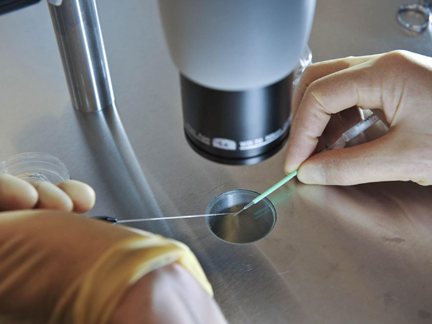|

Common dental problems in children
By Carol Aloysius
Dental problems in children have increased in recent years largely
due to changes in eating habits.
Unlike in the past, most children today yearn for sugar based foods
including sweets, cakes, chocolates, ice creams and fruit juices filled
with sugar. What is worse is that many of don't have proper dental
hygiene which has resulted in dental caries, and other dental problems.
The Sunday Observer spoke to Deputy Director Health Eduction Bureau,
Dr R.D.F.C. KANTHI for her views on this subject.
Q. What are the most common dental problems in schoolchildren?
A. Dental caries or dental decay, dental trauma and
malocchusen (irregular teeth.)
 Q. Of all of these what is the most common dental problem in
one sees among school children in Sri Lanka at present? Q. Of all of these what is the most common dental problem in
one sees among school children in Sri Lanka at present?
A. Dental caries.
Q. What is dental caries?
A. It means dental decay or cavities in the teeth.
Q. How do these cavities occur?
A. For two main reasons: Firstly due to high ingestion of
fermentable sugar in one's daily diet, and secondly due to poor oral
hygiene.
Q. How can eating sweet based foods harm the teeth?
A. Today, the trend is for children to eat adhesive sweets
that stick to the gums and teeth and are difficult to clean. Fermentable
carbohydrates contain acids that attack the tooth surface.
This is the initial stage of dental caries. Germs- a group of
bacteria called acid forming bacteria which are present in the plaque
thrive and multiply in the presence of sugar. The moment sugar
containing foods and drinks are consumed, these bacteria ferment the
sugar producing acid inside the plaque. The acid thus formed is strong
enough to attack the tooth under the plaque deposit and early decay
begins.
Q. What if the sugar concentration is low?
A. Even if the concentration of sugar consumed is low, if the
frequency of ingesting sugary foods is high it can still lead to dental
caries.
Q. Can the danger be reduced if one were to brush one's teeth
immediately after consuming a sweet food?
A. Yes. If sugar is taken in low concentration and
infrequently you can reverse the decaying process. Brushing the teeth
within an hour of eating something sugary will also reduce this process.
But remember to use toothpaste that has fluoride in it.
Q. Why?
A. Because fluoride provides resistance to acid that attacks
the tooth.
Q. Can brushing the teeth with fluoride stop a cavity that has
already formed in the tooth?
A. No. You can stop its formation by brushing regularly with
fluoride, but once the cavity has formed the child will need to have
his/her tooth seen by a dental surgeon and the cavity filled.
Q. What happens if the cavity is not filled and is neglected?
A. Then it will progress and can open the pulp cavity where
the blood vessels and nerves are exposed.
Q. How long does it take for a cavity to progress? Is it true
that it takes longer in adults than in children?
A. No. It depends on person to person and so many other
factors such as genetic factors, brushing of teeth with fluoride, etc.
Q. Once dental decay has passed through the enamel of the
tooth into the next layer, what happens?
A. Once dental decay passes through the enamel into the next
layer of dentine and then into the pulp of the tooth there can be severe
pain.
Q. Can this be reversed?
A. If it goes beyond to the pulp then it can only be repaired
with a root canal procedure.
Q. And if this too is jot done?
A. Further neglect can lead to the spread of infection
resulting in a dental abscess (alveolar abscess) which if untreated can
cause man complications. If caries has destroyed the tooth beyond repair
and a root filling is not done, the tooth will have to be extracted.
Q. Will this pose a problem?
A. It can change the appearance of the face and cause problems
with chewing.
Q. How will a child know whether he has a cavity in his tooth?
A. If he has a cavity he would feel it with his tongue. Or he
will feel extra sensitivity when he ingests hot or cold foods.
Q. What does a tooth- ache or pain in the tooth signal?
A. A tooth ache occurs only when the nerve is exposed.
Q. What is the treatment?
A. The dental surgeon will decide on the treatment. Usually it
could be a root canal treatment.
Q. How long does it take for a cavity to progress? Is it true
that it takes longer in adults than in children?
A. No. It depends on person to person and so many other
factors such as genetic factors, brushing of teeth with fluoride, etc.
Q. Dental fluoride is a common phenomenon in certain parts of
this island. How is it caused?
A. This occurs when a person ingests too much fluoride often
through the water sources which contain high levels of fluoride as in
the Dry Zone areas like Anuradhapura, Polonnaruwa, Jaffna, Moneragala.
Q. What are the symptoms?
A. The teeth become discoloured and stained.
Q. How much toothpaste with fluoride should a person use?
A. For children - size of a green gram seed. For adults - pea
size.
Q. Today it is common to see young children below 10 with gaps
in their teeth caused by early tooth extractions. Your comments?
A. This is because their teeth have decayed due to high
consumption of sugary foods and the cavities have not been attended to
in time.
Q. What happens if you extract milk teeth early?
A. If milk teeth are extracted early, then the dental arch
will collapse and the child will have irregular teeth which will affect
his appearance.
Q. Is this a disease? Are there other reasons for developing
malacuseum?
A. it is not a disease. It can be the result of
pre-extraction, or finger sucking or too many teeth. But it can cause
health problems because one could be unable to chew properly, cause
facial disfigurement, make it difficult to clean teeth properly which
can cause gingivitis or periodontal disease and also affect the
phonation ( sound production).
Q. What is periodontal disease? Is it common in school
children?
A. Gingivitis or periodontal disease is not a common childhood
disease. But those who don't brush their teeth well can develop it.
Q. How does it occur?
A. When the plaque containing bacteria which produces toxins
accumulates and causes inflammation of the gums (oedema) showing reddish
inflamed bleeding gums.
Q. Symptoms?
A. When brushing you can spot blood and sometimes there will
be a bad smell (halitosis) and a visible inflamed gum.
Q. You spoke about trauma at the beginning of our interview.
What is trauma with regard to teeth?
A. This can be an injury involving sports or a fight among
children when the anterior teeth can get injured especially the upper
teeth.
Q. What happens if this is neglected?
A. Then the tooth can die and will turn black there is no
blood flow. The child will be unable to bite his food and this will
affect his digestion. His facial appearance too will be altered.
Q. How can this be prevented?
A. To avoid this parents must immediately take their child to
a dentist. If it is a mild injury it can be corrected with a filling
depending on the situation.
The dentist will usually take an X-ray and thereafter decide on what
steps to take depending on the extent of the trauma and injury.
Q. What kind of services has the Health Ministry provided for
treating dental problems in children?
A. Most schools now have dental clinics for school children as
well as adolescent dental clinics which are all manned by qualified
dental surgeons. We also have special dental services for school
children on Saturday mornings on their school premises, children who
have been unable to attend the dental clinics during school hours can
attend.
Working parents who are unable to bring their children to the clinics
on week days can also come on a Saturday when they are free.
Or they can go to their nearest dental clinic which most state
hospitals now have and get treatment free of charge.
Q. Your message to students?
A. At least once a month, self examine your mouth in front of
a mirror and look out for any changes such as discolouration of the
teeth or cavities or swelling inside the cheeks, or gums. Brush your
teeth gently every morning and evening especially after meals using
tooth paste with fluoride.
Q. Finally your message to parents?
A. Caries is predominantly a childhood disease. It is thus a
responsibility of parents to inculcate healthy dietary habits in their
children from the earliest age. Avoid buying them sweet snacks and
drinks during the day.
If you need to give them a treat, limit a sweet snack to a main meal
preferably once a day.
Make sure your child brushes his/her teeth after every meal and after
consuming a sweet snack.
A tooth can last a life time if cared for well. Good oral hygiene
throughout life is the key.
'Three-parent babies': Britain votes strongly in favour of law
change
In a milestone for medical science, Britain is to become the first
country to allow the creation of so-called "three-parent" babies as MPs
voted overwhelmingly in favour of the controversial technique of
mitochondrial donation.
After a heated House of Commons debate, with MPs across the chamber
speaking passionately on both sides of the argument, the government
motion was passed in a free vote by a bigger-than-expected majority of
254 votes.
|

A leading scientist has urged caution about going ahead with
a so-called three-parent baby technique without further
extensive research into its safety |
The result marks a victory for the British researchers who have
pioneered the technique and the medical establishment that has backed
them. The motion was opposed by the Catholic Church, which objects to
the regulations on principle, and the Church of England, which was
concerned about the safety of the technique.
Government ministers accepted that mitochondrial donation, which
combines the DNA of three people into one IVF embryo, will for the first
time alter the human genetic make-up or "germ-line", not just of the IVF
babies created by the process, but of future generations of children
within affected families.
The proposed amendment to the 2008 Human Fertilisation and Embryology
Act will now be passed to the House of Lords, which will be expected to
give its approval within the next two weeks.
A senior science adviser warned at the end of last year that plans to
allow the creation of so-called 'three-parent' in vitro fertilisation (IVF)
babies were premature because of unresolved safety concerns about the
future health of the children.
The law allowing the licensing of mitochondrial donation will then
come into effect in October, opening the way for the first IVF licence
to be issued later this year, with the birth of the first three-parent
baby in 2016.
A health minister, Jane Ellison, told MPs that mitochondrial donation
is like replacing the battery packs of the cells with a new set of
batteries.
She emphasised it will not lead to a slippery slope of genetically
modified "designer babies" with enhanced inherited traits.
"For many families affected, this is the light at the end of the
tunnel," Ms Ellison told MPs at the end of the debate.
About 2,500 women of child-bearing age in Britain are thought to be
at risk of passing on mitochondrial disorders to their children. About
one in 6,500 babies is born with a severe form of the disease, which
affects vital organs such as the brain, heart and muscles.
Scientists at Newcastle University, which already has a licence for
research on IVF embryos using mitochondrial donation, said they expect
to apply for a full clinical licence later this year, once it becomes
legal for the Human Fertilisation and Embryology Authority to consider
applications.
Facing repeated interruptions from MPs from all parties, Ms Ellison
repeated the Government's position that mitochondrial donation is not
genetic modification because it only involves the movement of the 37
genes of the mitochondria - tiny energy-producing structures in the cell
- rather than the 22,000 genes of the chromosomes in the cell nucleus.
"No one would
say that this is not gr und-breaking science - it is. [But] we've
taken all rigorous steps for Parliament to make an informed decision,"
she said.
Labour's shadow health minister, Luciana Berger, supported the
amendment and said it will help affected families have healthy children,
but accepted that the technique is not guaranteed to be safe.
Fiona Bruce, a Tory MP who is opposed to mitochondrial donation
because it results in embryos being deliberately created and destroyed,
said that allowing the technique in law will set a dangerous precedent.
"We will be approving uncontrolled experimentation on children... Once
we approve this procedure, where will it end?"
Bishop John Keenan, the Bishop of Paisley, was among the Catholic
leaders who condemned the vote, claiming the technique "seeks to remove
anyone affected by certain conditions from the human gene pool".
- The Independent
Eternal life could be achieved by procedure to lengthen chromosomes
The key to eternal life could be a procedure to lengthen chromosomes.
The procedure would allow scientists to lengthen telomeres, the
protective caps that are on the end of chromosomes and shorten with age.
The telomeres protect chromosomes from getting damage as cells divide
and grow. But as they do, they slowly become shorter and eventually are
unable to protect the chromosomes. When that happens, they are liable to
deteriorate - thought to be a key part of the ageing process.
|

Procedure helps cells grow and could be used to treat a
range of diseases associated with ageing |
The new process allows scientists to lengthen the telomeres,
effectively turning back the biological clock and making the chromosomes
- and the people that are made out of them - younger.
When the cells have been treated, they behave as if they are younger
and multiply quickly rather than stagnating or dying.
The procedure could eventually be used to treat patients with genetic
diseases that lead to the telomere being shortened before it should be,
such as Duchenne muscular dystrophy. It could also be used to treat more
general symptoms of ageing, like diabetes and heart disease.
"This new approach paves the way towards preventing or treating
diseases of ageing," said one of the researchers on the study. "There
are also highly debilitating genetic diseases associated with telomere
shortening that could benefit from such a potential treatment."
The researchers behind the study hope that the procedure will be able
to allow scientists to generate large numbers of cells to study or use
to develop drugs.
The process has been discovered by Helen Blau of Stanford University,
who was senior author on a paper describing the procedure with John
Ramunas of Stanford and Eduard Yakubov from the Houston Methodist
Research Institute.
"Now we have found a way to lengthen human telomeres by as much as
1,000 nucleotides, turning back the internal clock in these cells by the
equivalent of many years of human life," said Helen Blau, who is also
professor of microbiology and immunology at Stanford and director of the
university's Baxter Laboratory for Stem Cell Biology. "This greatly
increases the number of cells available for studies such as drug testing
or disease modelling.
- The Independent
Illusion aids understanding of autism
New research could lead to a better understanding of how the brain
works in people with autism.
There is an enormous disease burden from autism, and little is known
about the cognitive processes involved.
Researchers looked at new theories of autism that focused on the way
in which the brain combines new information from its senses with prior
knowledge about the environment.
PhD student Colin Palmer said autism was a life-long condition that
affects many people in the community.
"It is still unclear what is happening differently in the brain to
produce the social, sensory and other difficulties that individuals with
autism can face," Palmer said. "We are testing a new type of theory,
which implicates the brain's capacity for making predictions about its
own sensory input. Autism may be related to problems with making those
predictions sensitive to the wider context. This means that new sensory
input is interpreted out of context, making it difficult to understand
the world and to generalise to new situations."
Using the 'rubber-hand' illusion, the researchers examined how adults
with autism experienced 'ownership' of a fake prosthetic hand. In the
'rubber-hand' illusion, one of the subject's hands is placed out of
sight, while a rubber hand sits in front of them.
- MNT |

